KYIV — Sitting on the front line of the war between Russia and Ukraine, Europe’s largest nuclear power plant is near the brink of a disaster that could imperil the Continent, according to international monitors and Ukrainian officials.
The situation is “extremely volatile,” said Rafael Grossi, the director general of the International Atomic Energy Agency (IAEA), which closely monitors the Zaporizhzhia facility in the southeast Ukrainian town of Enerhodar. Ukraine’s national energy company and former employees at the plant are also sounding the alarm.
“It is the most dangerous situation that we have,” Grossi told NBC News in an interview last week. “It’s my job not to sow panic, but at the same time I have to tell the truth about what is happening.”
There was growing international alarm when the site was shelled in the months after Russian President Vladimir Putin launched his invasion of Ukraine two years ago this Saturday, Feb. 24. And Ukrainian officials have also warned about staffing levels and general maintenance of the plant, which became operational in 1984.
Both sides have since blamed the other for attacks in the vicinity of the complex, which Russian forces seized shortly after the start of the war and is almost twice the size of Ukraine’s Chernobyl plant, the site of the deadly 1986 disaster widely considered the worst nuclear accident on record.

The atomic energy agency has repeatedly warned about the dangers of a direct attack on the site, although it has noted there has been no shelling of the facility since May.
However, Russian forces remain in control of the plant, which is right on the eastern bank of the Dnieper River, and all the territory around it, including the company town of Enerhodar. Ukrainian forces have maintained control of the river’s other bank.
As the focus of the fighting has shifted farther north, another concern is the frequent power outages at the plant, where eight blackouts have been reported since the start of the war, the most recent in December, according to both the IAEA and Energoatom, Ukraine’s national energy company.
“When you have a blackout, lack of external power supply at a nuclear power plant, the cooling function of the reactors is lost, and you could have a meltdown,” Grossi said.
He added that the situation could be compared to 2011’s disaster at the Fukushima Daiichi Nuclear Power Plant in Japan, when three reactors melted down in an accident caused by a huge tsunami that battered the country’s eastern coast.
Zaporizhzhia is different because the plant’s six Soviet-era reactors were put into semi-shutdown to stop the nuclear fission reaction and generation of heat and pressure shortly after the start of the war. As a result, they are in a colder state than those in Fukushima and therefore less volatile.
Powering the plant has nonetheless become increasingly difficult because three of the four lines supplying the complex have been destroyed and the fourth is faulty, according to Petro Kotin, the CEO of Energoatom, which ran the facility before it was taken by Russian forces.
For now, the plant is relying on 20 backup diesel generators to keep the reactors operating safely, said Kotin, who is still in contact with a number of Ukrainian workers at the plant.
The destruction of the Kakhovka dam farther up the Dnieper River has also proved problematic for operators at the plant. Water from the dam’s reservoir had been used to cool the reactors, which now could overheat and melt down if turned on.

New wells are being drilled at the plant to make up for the supply of cooling water lost by the dam’s collapse, according to the IAEA.
Another serious point of concern is the lack of qualified staff to oversee safety under the plant’s current operators, a subsidiary of the Russian state nuclear company, Rosatom.
Before the war, about 11,000 employees worked at the plant, many of whom fled as Russian forces advanced. Now there is just a skeleton crew of about 4,000, according to Energoatom, which like Kotin still receives information from both current and former staff members.
Kotin said the Ukrainian staff who stayed behind were forced “under pressure and even under torture” to sign contracts with Rosatom.
NBC News has asked Rosatom for comment on power supply and the staffing issues at the plant.
After the plant fell into Russian hands, Serhii Romanyuk said he reluctantly continued to work there as a deputy head of nuclear safety, which meant he was responsible for the safe storage of new and used nuclear fuel.
But in September 2022, he said he was called into the office of the main engineer and was arrested by representatives of the Federal Security Service (FSB) — the domestic intelligence service that succeeded the Soviet-era KGB.
Romanyuk said they wanted to know if he had a weapon, so they escorted him back to his apartment in Enerhodar to conduct a search.
“They put a hot iron on my chest, choked me, they put a bag on my head so I couldn’t breathe,” he said. “All of that was followed by a beating.”
Although they did not find a weapon, he said they took him to a police cell where he was held in a small, windowless room, crammed with people.
The interrogations and the beatings continued, but this time he said they were searching for information about other members of the staff who were pro-Ukrainian.
“They were trying to convince me to collaborate with them, but it wasn’t about working at the nuclear plant,” he said. “They were interested in some other field of collaboration.”
After more than a month in captivity, he said was released after he refused to cooperate.
Now living in Kyiv, Romanyuk said he feared for the plant because of the poor quality of the remaining staff and the degradation of equipment. On the few occasions he has received information about the facility, he said it appeared that “nothing is done there in terms of maintenance.”
Allegations of abuse against Ukrainian workers have been widespread since Russia took over the plant. A recent investigation by the Ukrainian human rights organization Truth Hounds featured testimony from several people who also alleged similar treatment. It said that Ukrainians on site were targeted for suspicion of working with Ukrainian forces, cooperating with the country’s intelligence services or of having anti-Russian views.
NBC News has asked the FSB and Rosatom for comment about the allegations that workers at the plant have been tortured.
Kotin, the Energoatom CEO, warns that the staffing issue is affecting the overall maintenance of the plant, further increasing the chance of something going wrong and that this is getting worse because of the degradation of the site.
“You can get to the point when any small event somewhere will bring just a cumulative effect,” he said. “After that, you will have this disaster.”
Richard Engel and Charlotte Gardiner reported from Kyiv, and Gabe Joselow from London.

